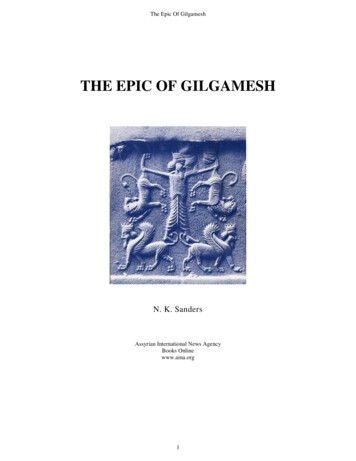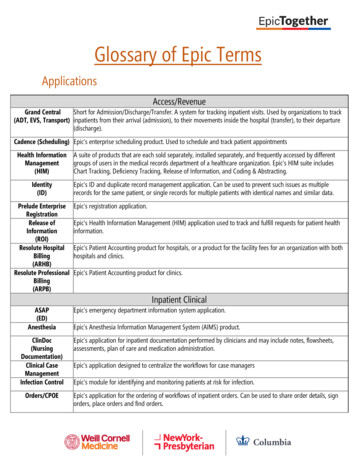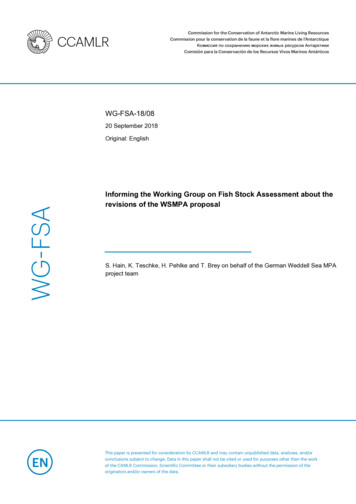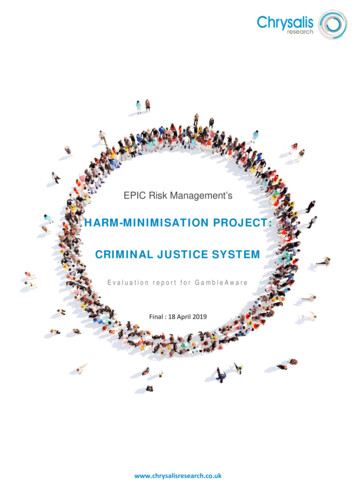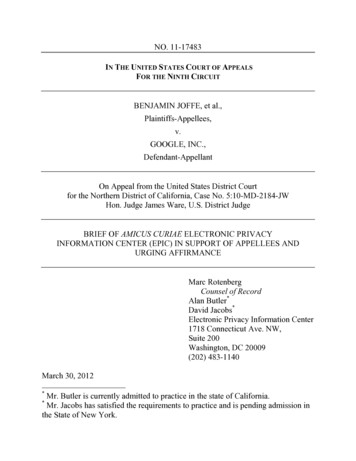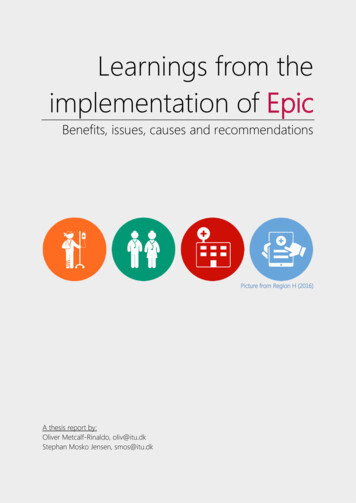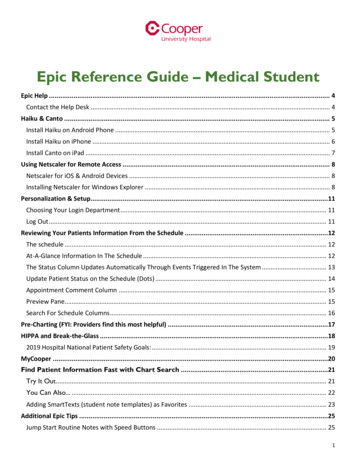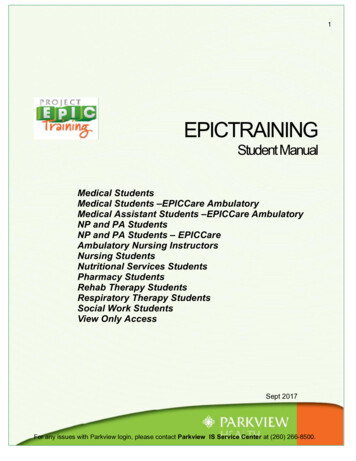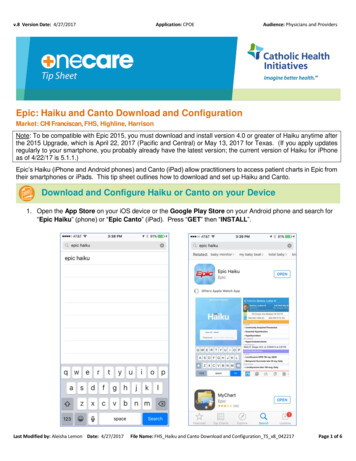
Transcription
Book reviewsON THE EPIC OF GILGAMESH IN ESTONIAN1Gilgameši eepos. Akkadi keelest tõlkinud ja seletused kirjutanud Amar Annus 2010. [The Epic of Gilgamesh: Translatedfrom the Akkadian language and commented by Amar Annus.] Bibliotheca Antiqua, Tallinna Ülikooli Kirjastus, 242 pp.The Babylonian Epic of Gilgamesh2 is one of the oldest and mostfamous epics in the history of mankind, which was extremelypopular in ancient Near East during the 2nd and 1st millenniaBCE and probably even later. Along with the Epic of Gilgamesh3,another Babylonian epic Enūma elîš4 has supposedly influencedthe most well-known heroic epic or epic poems of Ancient NearEastern cultures and countries, such as Babylonia, Assyria,Hittite kingdom, kingdom of Mitanni (Khanigalbat), Amoritekingdom of Yamhad, kingdom of Nuzi, kingdom of Kizzuwatna,kingdom of Urartu, and also city-states, such as Mari, Ugarit, Emar, Carchemish andHalab (modern Aleppo), as well as other Syrian, Palestinian, Anatolian or Mesopotamian city-states and kingdoms. The poem was well known in the scribal tradition inMesopotamia, ancient Egypt, Palestine, Urartu, and Iran (Achaemenid Persia) duringthe reign of Alexander the Great and later in Hellenistic Seleucid Empire.Some elements of The Epic of Gilgamesh could also be found in Greek-Roman mythological legacy and in literature: theogonies, myths, poems, and the like, as well as lateron in Late Antiquity and supposedly partly also in the medieval Near Eastern literature:in Arabic and Persian poems, tales literature, for example Odyssey, Cycle of Heracles,Alexander romance, Persian national epic Shahnameh, etc. (see, for example, Dalley1991: 1–17).The Epic of Gilgamesh has been published many times in English, French, German,Russian, and other languages (see, for example, Diakonov 1961; George 1999, 2003,2007). This very famous epic poem was also published in Estonian by Boris Kabur in1994 (Kabur 1994). Although Boris Kabur (1917–2002) was an author and translator,he was not an Assyriologist or philologist in the field of ancient Near Eastern studiesand he did not know the Akkadian language; hence, his translation was mainly made onthe basis of Russian (I. M. Diakonov’s translation: Diakonov 1961) and English versions.In 2010, the second Estonian translation of the Epic of Gilgamesh was published.The original text was translated and commented by Assyriologist Dr. Amar Annus. Hehas published several articles, translations and a book in the field of Assyriology.The new Estonian translation of The Epic of Gilgamesh by Amar Annus includesAcknowledgments, Introduction, Estonian translation of the Epic (altogether 12 tablets),Commentaries, Hittite “Gilgamesh” (written by Jaan Puhvel), Bibliography, Glossary,and List of Illustrations – altogether 242 pages. It is the only scientific translation ofThe Epic of Gilgamesh in the Estonian language.Amar Annus’s translation is quite accurate, made directly from the Akkadian language. Amar Annus is a very talented translator and he is also an expert in decipheringAkkadian and Sumerian cuneiform texts (see, for example, Annus 2001; MKA: 23–47,55–95, 137–202, 239–254; 260–271; Annus & Lenzi 2010).Folklore 53193
Book reviewsThis is not only a good translation from Akkadian, but also a profound analysis ofthe epic and it is one of the reasons why this translation can be designated as scientific.However, the translator has neglected the Akkadian transliteration in this work. In myopinion it would have been very good if this edition of The Epic of Gilgamesh had alsoincorporated Akkadian transliteration of all the 12 tablets. It is certainly understandable that this edition is meant not only for the orientalists and specialists in the fieldof Near Eastern Studies, but also for other readers who are interested in reading thisliterary masterpiece. However, with Akkadian transliteration it would be more usefulfor specialists and scholars who work with this epic, and it could also be very helpfulfor students in learning the Babylonian dialect of the Akkadian language. The secondcritical remark concerns the fact that the book does not include an index part, whichcould also be very useful for working with The Epic of Gilgamesh.Having discussed the abovementioned shortcomings, I have to point out that thetranslation of The Epic of Gilgamesh by Amar Annus has a very profound introduction(Gilgameši eepos 2010: 11–58) and commentaries (Gilgameši eepos 2010: 193–226),which also include some remarks about Hittite Gilgamesh provided by an eminent Hittitologist and linguist, professor emeritus of the University of California, Jaan Puhvel(Gilgameši eepos 201: 223–227).The first known version of The Epic of Gilgamesh – the survived fragments of cuneiform texts – was written in the Old Babylonian dialect of the Akkadian language. Itcan be traced back to the Old Babylonian period based on ductus (Ger. Schreibstiel) andthe style of cuneiform signs – the so-called Pennsylvania Tablet (dates from approximately 18th or 17th centuries BCE). It seems that the Standard Version of The Epicof Gilgamesh originated from a later period – from the end of the Middle Babylonianperiod (ca. 13th–11th centuries BCE) (Gilgameši eepos 2010: 33).The opening words of the Standard Version of the Epic of Gilgamesh are ša naqbuīmuru – “He, who saw the Deep” (Gilgameši eepos 2010: 33). The author of this Standard Version is a Babylonian scholar and scribe Sîn-lēqi-uninni, who edited the Epic ofGilgamesh and unified it in one poem that consists of 12 tablets. Sîn-lēqi-uninni wasprobably a historical figure who lived in the Middle Babylonian period approximatelyduring the epoch 1300–1100 BCE; however, we cannot exclude the possibility that hecould have lived even some centuries earlier, most probably only after a few rulinggenerations after the reign of Hammurabi (1792–1750), who was the most famous kingof the First Dynasty of Babylon and the founder of the Old Babylonian Empire.Many motives, storylines and roots of The Epic of Gilgamesh are older than the OldBabylonian or Middle Babylonian periods and they originate from the Sumerian period– 3rd millennium BCE. From the Ur III period (2112–2004 BCE) we have 5 independent short stories or, to be more precise, epic heroic songs on Bilgamesh (Sumerian formof the name Gilgamesh). Those five epic songs (probably more stories about the divinehero and King Bilgamesh and his deeds existed in Sumer, but those have not been foundyet) were written in the Sumerian language (Neo-Sumerian dialect) in the Ur III periodor later during the Isin-Larsa period, when Sumerians already assimilated with theAkkadians and Amorite people. Hereby it is necessary to mention that these Sumerianshort epic songs or poems about the adventures and heroic deeds of the king of UrukBilgamesh, such as Bilgamesh and Akka (see, for example, the Estonian translationof Bilgamesh and Akka by Vladimir Sazonov and Raul Veede in MKA: 49–53; see also194www.folklore.ee/folklore
Book reviewsSumerian original, the ETCSL transliteration: c.1.8.1.1; see also the edition Römer 1980),Gilgamesh and the Bull of Heaven (ETCSL transliteration: c.1.8.1.2), Gilgamesh, Enkiduand the Netherworld (ETCSL transliteration: c.1.8.1.4; Shaffer 1963), Gilgamesh andHuwawa (ETCSL transliteration: c.1.8.1.5 and c. 1.8.1.5.1) and The Death of Gilgamesh(ETCSL transliteration: c.1.8.1.3; see also Espak 2009: 25; Cavineaux & Al-Rawi 2000:241–242) were extremely popular in earlier times – in Old Sumerian (or Presargonic, ca2900–2335 BCE) and Old Akkadian (2334–2154 BCE) oral tradition, and they belong tothe folklore legacy of Sumerians and Akkadians. In my view they obviously existed inSumerian oral tradition in very early times – in the Presargonic period (2900/2800–2330BCE). It seems quite possible that the first stories – epic songs about Bilgamesh – werealready composed in one-two or at least three generations after the death of the hero, themost famous king of the First Dynasty of Uruk – Gilgamesh, who hypothetically livedand reigned in Southern Sumerian city-state Uruk approximately in 2700–2600 BCE. 5Nevertheless, Gilgamesh was deified after his physical death, people prayed to himas God in the hope of getting help and support in the fight against demons and illnesses.In Ancient Mesopotamia he was not only a protector of the mankind and civilization,who fought with zoomorphic demons (bulls or lions with human heads: several motivescan be found in Mesopotamian art, especially in cylinder seals; see about the cylinderseal, for example, Moortgat 1940), but also in Neo-Sumerian period he was a patronor friend and brother of the ruling king – as in the reign of Ur-Namma (2012–2094) orŠulgi6 (2093–2046).7 Additionally, Gilgamesh was also represented as a very importantdeity in the Netherworld8. But whether Gilgamesh really was a historical figure or notis a complicated question that we cannot discuss here in this short review.9To conclude, we can say that it is very important and necessary to publish a newcommented edition of The Epic of Gilgamesh in Estonian with a profound historicophilological introduction and analysis. Let us hope that in the future several translationsof other important and significant oriental poems, epics, myths, and epic songs such asAtra-hasis10, Enki and Ninmah11, and others, will be published in Estonian.Vladimir SazonovNotes1I am very grateful for editing this review and for his critical remarks to Mr. ParvizPartovi. This review was published with the support of ETF grants 8993 and 8669.2See about The Epic of Gilgameš in George 2003.3George 2003; Schaffer 1963.4See the new edition of Enūma elîš by Thomas R. Kämmerer and Kai A. Metzler (Kämmerer & Metzler 2012); see also Espak 2010: 191–192.5IDV I: 168–170; Sallaberger 2008: 46–49; Selz 2005: 43–44.6About Šulgi see, for example, Sazonov 2008: 84–107.7Klein 1976: 271.Folklore 53195
Book reviews8About the Netherworld see Katz 2003; Sazonov 2012: 87–98; Espak 2009: 19–29.9See more about Gilgamesh in, for example, Annus 2012: 44–45; Sallaberger 2008.10See, for example, Espak 2010: 189–190.11See, for example, Espak 2010: 186–188.ReferencesAnnus, Amar 2001. The Standard Babylonian Epic of Anzu: Introduction, cuneiform text,transliteration, score, glossary, indices and sign list. Helsinki: The Neo-AssyrianText Corpus Project.Annus, Amar & Lenzi, Alan 2010. Ludlul Bēl Nēmeqi: The Standard Babylonian Poemof the Righteous Sufferer, State Archives of Assyria Cuneiform Texts 7. Helsinki:The Neo-Assyrian Text Corpus Project.Annus, Amar 2012. Louvre Gilgamesh (AO 19862) is depicted in life size. NouvellesAssyriologiques Bréves et Utilitaires (NABU), No. 32, pp. 44–45.Cavineaux, Antoine & Al-Rawi, Farouk N. H. 2000. Gilgameš et la mort: Textes de TellHaddad VI avec un appendice sur les texts funéraires sumériens. CuneiformMonographs 19 ( CM 19), Groningen: Styx Publications.Dalley, Stephanie 1991. Gilgamesh in the Arabian Nights. Journal of the Royal AsiaticSociety, Vol. 1, pp. 1–17.Diakonov, Igor M. 1961. Epos o Gil’gameshe, perevod s akkadskogo. [The Epic of Gilgamesh: Translation from Akkadian.] Moskva & Leningrad: Izdatel’stvo Akademiinauk SSSR.Espak, Peeter 2009. Mesopotaamia kosmiline geograafia ja Abzu: Päikesejumala reisallilma. [Mesopotamian Cosmic Geography and Abzu: Sun God s Journey to theUnderworld.] Eesti Akadeemilise Orientaalseltsi aastaraamat 2008 (3), pp. 19–29.Espak, Peeter 2010. The God Enki in Sumerian Royal Ideology and Mythology. Doctoralthesis. Tartu: Tartu University Press.ETCSL The Electronic Text Corpus of Sumerian Literature. http://etcsl.orinst.ox.ac.uk/, last accessed on March 28, 2013.George, Andrew R. 1999. The Epic of Gilgamesh: A New Translation. Penguin Books.George, Andrew R. 2003. The Babylonian Gilgamesh Epic: Introduction, Critical Editionand Cuneiform Texts. Oxford: Oxford University Press.George, Andrew R. 2007. The Gilgameš Epic at Ugarit. Aula Orientalis No. 25, pp.237–254.IDV I Diakonov, Igor M. 1983. Istoria Drevnego Vostoka. Čast pervaja. Mesopotamia.[History of Ancient Near East. Part One. Mesopotamia.] Moskva: Glavnaya redakcia vostočnoi literatury.Kabur, Boris 1994. Gilgameš: “Sellest, kes kõike näinud”. Sinlikiunninni Gilgameši lugumanatarga Sinlikiunninni sõnade järgi. [Gilgamesh: “About the One Who HasSeen Everything.” The Story of Gilgamesh by the Words of Exorcist Sinlikiunninni.] Translation and epilogue by Boris Kabur. Tallinn: Kupar.196www.folklore.ee/folklore
Book reviewsKämmerer, Thomas R. & Metzler, Kai A. (eds.) 2012. Das babylonische Weltschöpfungsepos Enūma elîš. Alter Orient und Altes Testament 375, Münster: Ugarit-Verlag.Katz, Dina 2003. The Image of the Netherworld in Sumerian Sources. Bethesda: CDLPress.Klein, Jacob 1976. Šulgi and Gilgameš: The Two Brother-Peers. Kramer AnniversaryVolume: Cuneiform Studies in Honor of Samuel Noah Kramer. Barry L. Eicher(ed.) with the assistance of Jane W. Heimerdinger & Åke Sjöberg. Alter Orientund Altes Testament 25, pp. 271–292.MKA Annus, Amar (ed.) 2005. Muinasaja kirjanduse antoloogia. [Anthology of Prehistoric Literature.] Tallinn: Varrak.Moortgat, Anton 1940. Vorderasiatische Rollsiegel. Ein Beitrag zur Gesichichte der Steinscheidekunst. Berlin: Verlag Gebr. Mann.Römer, Willem H. Ph. 1980. Das sumerische Kurzepos “Bilgameš und Akka”. AlterOrient und Altes Testament 209/1, Neukirchen-Vluyn.Sallaberger, Walther 2008. Das Gilgamesch-Epos. Mythos, Werk und Tradition. München:Verlag C.H. Beck.Sazonov, Vladimir 2008. Kuningas Šulgi laul: mõned märkused Uus-Sumeri kuningaŠulgi (2093–2046) kuningavõimu ideoloogia kohta. [The Song of Šulgi: SomeRemarks Concerning the Royal Ideology of the Neo-Sumerian King Šulgi (20932046 BC).] Usuteaduslik ajakiri 1, pp. 84–107.Sazonov, Vladimir 2012. Kirves Nergali jaoks. Täheldusi sumerite ja akkadlaste allilmakujutlustest. Tõlge sumeri keelest ja kommentaarid. [An Axe for Nergal.Observations on Sumerians’ and Akkadians’ Conceptions of the Netherworld.Commented
most famous king of the First Dynasty of Uruk – Gilgamesh, who hypothetically lived and reigned in Southern Sumerian city-state Uruk approximately in 2700–2600 BCE. 5 Nevertheless, Gilgamesh was deified after his physical death, people prayed to him as God in the hope of getting help and support in the fight against demons and illnesses.
